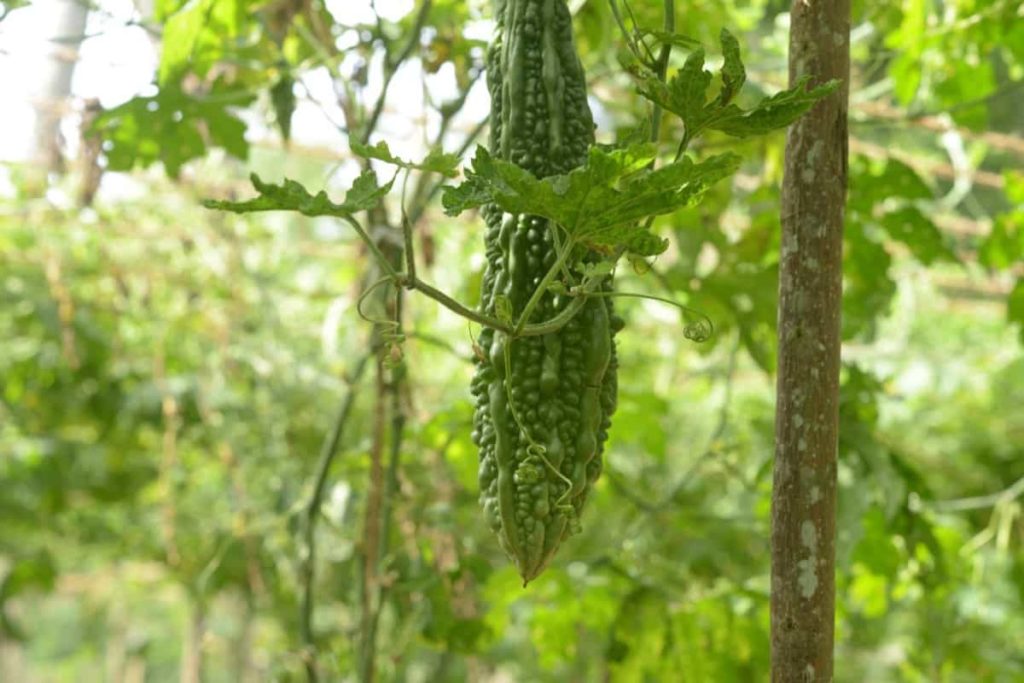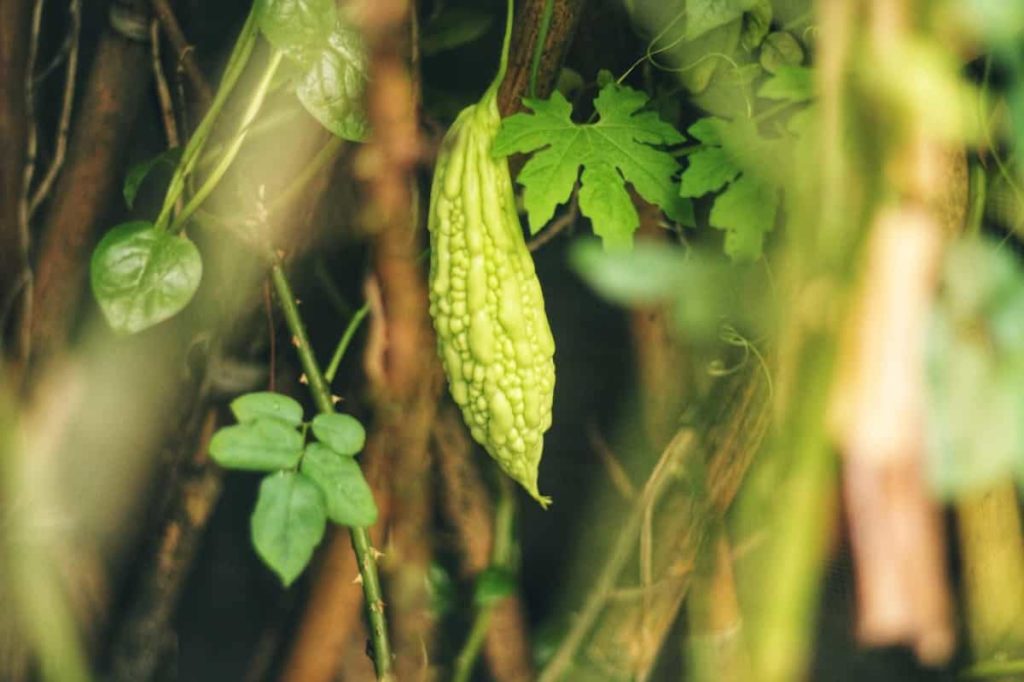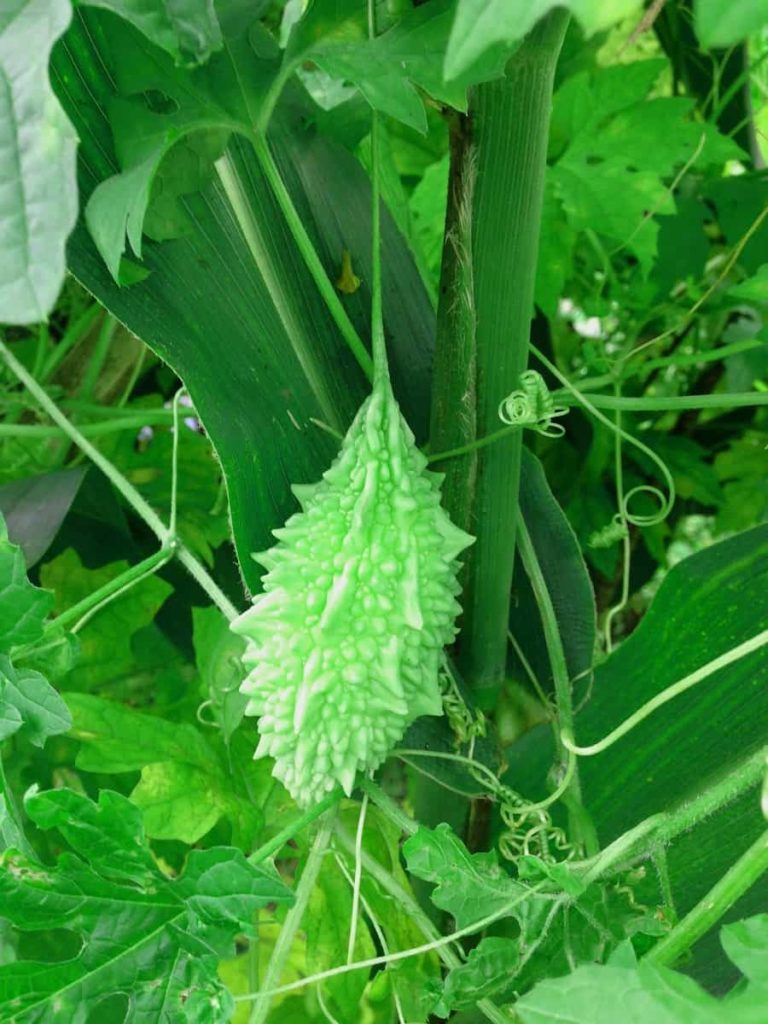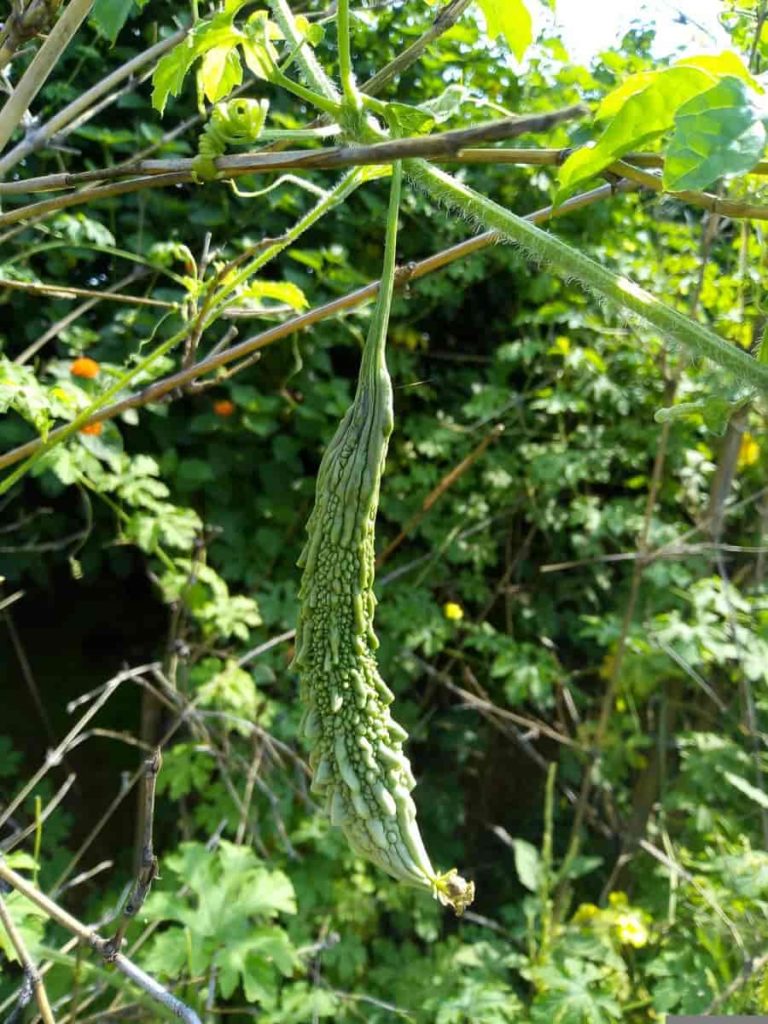Bitter melon or Bitter gourd is a vining plant that grows like cucumber or melon in the hot summer sun. The length of Bitter gourd vines can grow from 150 to 190 inches. Therefore, it is recommended to keep pruning the plant regularly and use vertical support to save space. The leaves of Bitter gourds are prominently lobstered, while the skin of the Bitter gourd is sharp and highly knifed. The flesh of the Bitter gourd under the skin is creamy white and firm. Like most summer vegetables, Bitter gourd is easy to grow in your kitchen or terrace garden.

How to grow Bitter Gourd/Bitter Melon from seed to harvest
How long does it take to grow Bitter gourd?
- Bitter gourd is a slender creeper trained on trellis with dark green or greenish-white oval fruits with blunt tubercle tappers at the end. The climber also creates an ornamental hedge.
- It takes around 55 to 60 days for the Bitter gourd crop to reach the first crop from seed sowing. Therefore, further selection should be done at 2 to 3 days intervals as Bitter gourd fruits mature quickly and turn red.
- Harvest a Bitter melon 8 to 10 days after flowering when the fruits are 4 to 6 inches long. The fruits will be slightly pear-shaped, with light green skin and a few stripes of yellow.
What is the best month to plant Bitter gourd?
- In the plains, the summer crop is sown from January to February, while the rainy season crop is sown in May. 4 to 5 kg seeds are required for a one-hectare area. Therefore, you should treat the seeds with thiram 3 gram per kg seeds before seeding.
- Since Bitter melons are tropical plants, they are best grown from seeds indoors. You should start sowing Bitter melon seeds about four weeks before the last frost date in spring. Germination usually takes place within seven days but can take 14 days.
- Bitter gourds thrive well in hot and humid climates. Summer (late April and May) is the best season to sow Bitter gourd seeds. You should avoid excessive use of water and fertilizers for the healthy growth of plants.
Can we grow Bitter gourd from fresh seeds?
- Bitter gourds can be grown from seeds taken from ripe fruit or seed packets. Note that growing with fresh seeds is best. It’s a climber that needs trellis and fertile, well-drained soil to thrive.
- Bitter gourds need a very hot and humid climate to grow well. Plant Bitter gourd seeds at a place that receives 6 to 8 hours of sunlight daily. Seed germination can take 7 to 14 in soil temperature from 15°C to 20°C. The Bitter gourd will take about 55 to 60 days to mature.
What are the common problems of Bitter gourd?
- Bitter gourd Mosaic – Some leaves show vein clearing in one or two leaf lobes, and severely affected plants show a decrease in leaf size and length and suppression of one or two lobes. Young developing leaves are completely deformed and distorted and have a considerable reduction in size.
- Powdery mildew – This disease is favored by high humidity and occurs first on old leaves. The symptoms first appear mainly as white powdery residues on the upper surface of the leaf.
In case you missed it: Bitter Gourd Gardening for Beginners, How to Start

Which fertilizer is best for Bitter gourd?
- Generally, well-decomposed farm yard manure, 15 to 20 tons per hectare, is mixed with soil during cultivation.
- The recommended dose of fertilizer is 50 to 100 kg nitrogen, 40 to 60 kg P2O5, and 30 to 60 kg K2O per hectare.
- It is necessary to use half nitrogen (N) and whole phosphorus (P), and potassium (K) before planting Bitter gourd seeds.
- Balance Nitrogen is given at the time of flowering. The fertilizer is applied to a ring of 6 to 7 centimeters from the base of the stem. It is better to complete all fertilizer applications before the fruit set.
- Organic fertilizers for Bitter gourds are weeds, kitchen scraps, and manure.
- Homemade organic tea fertilizers are fish emulsion fertilizers and seaweed fertilizers.
- Bitter gourd fruit produces the highest fruit yield when irrigated at 10-day intervals, and urea is applied to a 3.0% concentration.
Does Bitter gourd need sun or shade?
- Bitter gourd requires a very hot and humid climate to grow well. Plant Bitter gourd seeds at a place that receives 6 to 8 hours of sunlight daily. Like other squash family members, Bitter melons produce vines 13 to 16 feet long.
- Bitter gourd is a hot weather crop. Bitter gourd needs 6 hours of full sun to flourish. And it can thrive in a partial shade with good light and air circulation.
- Plant Bitter melon where it gets at least 6 hours of sunshine. In the southern regions, it is fine to site seedlings in a place with a light shade, as long as the vine can ramble in areas of full sun.
How do you make Bitter gourd bigger?
- It’s a climber that needs trellis and fertile, well-drained soil to thrive. Planting Bitter gourd on the ground will give it more root space and result in a larger and more productive plant. The growing area should receive direct sunlight for at least six hours daily.
- Sow about 1/2 inch deep in loamy, well-drained soil prepared with aged manure or compost. You can also soak Bitter gourd seeds overnight to increase germination speed. You can plant the soaked Bitter gourd seeds directly in the garden and cover them with soil. You should keep the distance between the two plants at least 12 to 15 inches.
- Keep the soil evenly moist until grown. So, it’s essential to keep checking the soil with the tip of your fingers and the tip of the water if it feels dry when touched.
- Regular pruning of side shoots is also necessary to improve fruiting and control plant growth.
- Like most cucurbits, Bitter gourds are sensitive to pests such as aphids, cucumber barks, and fruit flies. It is essential to check your vines and remove them manually or use a neem oil spray. To control pests, remove weeds around the Bitter gourd plant. Garden-friendly insects like ladybugs are also beneficial in controlling pests.
How can I increase the yield of Bitter gourd?
- While Bitter gourd seeds can withstand almost all soil types, if you want to increase yield, be sure to plant them in well-drained sandy loam soil. The soil should contain organic matter, and the perfect pH is within 5.8 to 6.6. It is wise to add compost to improve the soil and achieve abundant yield.
- Keep in mind that the roots of Bitter gourd decompose on moist soil, so it is better to grow them in trellis vines. If you have space in a vegetable garden, grow the seeds on the fence or squarely distribute support.
- Sow bitter seeds in about 1.25 centimeters holes and make space at a distance of 30 centimeters. For maximum production, use potassium-rich and phosphorus fertilizers and a smaller amount of nitrogen. This fertilizer depends on soil fertility and plantation season.
- The seeds grow in 7 to 14 days if all conditions are met. However, please note that extreme temperatures and unbalanced soil can slow down germination.
- One of the best ways to prevent flies is to protect the fruits with paper bags or cover them with newspaper when the plants are 2.55 or 5 centimeters long.
In case you missed it:Bitter Gourd Growing Tips, Tricks, Ideas, and Secrets

How many Bitter melon does a plant produce?
- Each Bitter gourd plant will produce 10 to 12 fruits and maybe something more. Bitter melons are a warm-season crop best suited for growing in tropical and subtropical heat and humidity. Grow Bitter melons where the day temperature averages between 24°C to 31°C.
- The production of Bitter gourd varies according to the cultivation system, variety, weather, and many other factors. However, the average fruit yield ranges from 8 to 10 tons per hectare.
Can Bitter gourd be grown in pots?
- All you have to do is use good soil, water them daily and place them where they will get plenty of sunlight. And they will reward you with a good yield. So, easy to grow Bitter gourd in pots.
- Bitter gourd grows well in medium-sized containers. Choose containers 12 inches deep and 10 inches wide to grow Bitter gourd. The Bitter gourd plant grows up to 5 meters long and requires a strong trellis.
- Growing Bitter melons in pots like Squash, Cucumbers, and Melons is easy. Bitter melon vines can be more than 5 meters long.
- Bitter gourd needs well-drained soil to flourish. You must fill the container with a potting mix and leave 1 inch from the rim of the container. Plant the seeds directly in the containers; otherwise, you can sow the seeds in the seed tray. Do not tap the soil tightly; the seeds need air and light access to grow.
Can Bitter gourd grow in winter?
- The growth requirements of Bitter gourd are usually a long period of the warm, preferred dry season with plenty of sunshine. The dry season during fruit maturity is essential for the good quality of fruits. It has also not been adapted to resist mild frost and will have to be given adequate protection if grown in the winter months. Bitter gourd is usually grown in summer and the rainy season. It can be cultivated throughout the year in the south and central India.
Why is my Bitter gourd turning yellow?
- Nutrient deficiency is the main cause of yellow leaves in Bitter gourd. Yellow leaves with yellow veins (especially at older growth) are a sign of nitrogen deficiency, although it can sometimes affect whole leaves.
- Bitter gourd yellow mosaic virus (BGIMV) is whitefly transmitted Geminivirus. The disease attains significance because the virus that causes the disease can attack the crop at every stage.
- Bitter melon is often eaten before it ripens when it is green or begins to turn yellow. The flesh turns yellow as it matures, the moment it becomes even bitterer.
How do I make my Bitter gourd plant healthy?
Once the Bitter gourd seeds start flowering, you need to add organic fertilizer to stimulate healthy growth and an adequate amount of fruit. Make sure you water after adding fertilizer. Bitter seeds are required for moist soil for growth and fruit production. Never give much water because it will kill the roots.
In case you missed it: Growing Organic Bitter Gourd – On Terrace At Home

Why do Bitter gourd flowers fall off?
- Bitter melon needs to be pollinated to produce fruit; both male and female flowers are found on the plant; the male flower is usually opened for only one day and falls from the plant. Flies and insects travel from one flower to another from which fertilization occurs, and the remaining flowers are female.
- Your flowers are falling off because you lack pollinators such as bees. Plant some Zinnias, Marigolds, Petunias, Coneflowers, etc., to get pollinators in your yard. For example, gourds have male and female flowers, and pollen has to move from one to the other.
How often do you water Bitter melon?
- Keep the Bitter melon bed evenly moist; regular water is essential for the growth and development of fruits.
- You should water your plants deeply at least once a week, more frequently if the soil is dry below the first 3 inches of soil. You should cover the growing bed with mulch to help maintain moisture.
- Bitter gourd requires a good amount of water to thrive, and the water plant is regularly used to maintain a constant moisture level in the soil. Bitter gourd seeds take a few weeks to grow. Once the plant emerges, inspect the plant growth regularly. Water the plant generously and regularly.
- Keep the soil evenly moist until grown. Since Bitter gourds are grown in the hot summer months, the soil will need to be watered repeatedly once the seedlings are established. The soil in containers dries relatively faster.
How long does it take to grow Bitter melon from seed?
- The seeds will start growing within 7 to 12 days of sowing, and the flowers will appear in 5 to 6 weeks. The Bitter gourds will be ready to pick up within 2 to 3 months from planting. Bitter gourds are grown from seeds taken from ripe fruit or seed packets. Note that growing with fresh seeds is best. It’s a climber that needs trellis and fertile, well-drained soil to thrive.
- Bitter gourds seeds need a very hot and humid climate to grow well. Plant Bitter gourd seeds at a place that receives 6 to 8 hours of sunlight daily. It will take ten days for the seeds to germinate in soil temperature from 15°C to 20 °C.
- Caring for Bitter melon plants dictates planting when there is no risk of frost and temperatures warm up. Seeds grown as an annual crop can be obtained from multiple suppliers and sown directly in almost any soil variety, although growing Bitter melons work best in deep, well-drained, sandy, or silt loam.
In case you missed it: Bitter Gourd Seed Germination, Time Period, Procedure

Does Bitter gourd have male and female flowers?
- In Bitter gourd, female and male flowers are produced separately on the same plant, and male flowers usually exceed the ratio of 25:1 to female. Spraying vines with flowering hormones will increase the number of female flowers after 6 to 8 true leaves and can double the number of fruits.
- Every gourd vine has female and male flowers. Male flowers usually appear first. You can easily differentiate male from female flowers because the shape of the female flower will be the shape of the small pellet under the flower, while the male flower grows on the stem without the shape of the ball under the flower.
How many times can you harvest Bitter gourd?
- Being patient and allowing them to grow and develop properly is very important. You can expect to see fruits 55 to 60 days after planting.
- Once the melon starts to ripen, pick fruit regularly every two to three days. To save seeds for the next season, leave some fruit on each vine to mature the past crop.
- If the fruits are left to ripen on the vine for longer than that, they will begin to change color to pale orange and become undesirable. Cut the Bitter gourd fruit every 2 to 3 days with a sharp knife to promote new fruits during the season.
How do you pollinate Bitter gourd flowers?
- The Bitter gourd plant is a cross-pollinated crop. Insects, especially bees, pollinate flowers. During the wet season, the pollination process can be a problem as the flies are less active during cloudy conditions.
- Hand pollination is a straightforward procedure. This involves simply stirring or tapping the pollen from the male flower to the female flower. Most gourd flowers bloom at night and usually last only one night.
How do you protect Bitter gourd from insects?
- Use ribbed gourd as a trap crop and apply 0.15% or malathion 0.1% on congregating adult flies on the leaf subsurface.
- Apply a bait containing 50 ml malathion and 0.5 kg of sugar in 50 liters of water and can be repeated at weekly intervals if the attack is severe.
- The fruit fly is the most destructive pest of Bitter gourd. You can prevent this by bagging fruits and fruit fly traps and pheromone traps. Field sanitation is also necessary to avoid pest recurrence.
- Aphids can be easily controlled by spraying malathion (0.1%) or Metasystox (0.1-0.2%) sufficiently early before the attack becomes severe. You can usually mix sprays against aphids and beetles.
Why Bitter gourd is not fruiting?
- Insects and bees pollinate Bitter melons. If there are flowers but no fruit forms and you don’t find a bee at work in the garden, you may rightly suspect that the pollination has not occurred.
- Bitter gourd requires fertile, well-drained soil with pH levels between 5.5 and 6.7. Bitter gourd thrives well in soil with rich organic matter. The Bitter gourd plant constantly needs water and produces fruit 4 to 6 months after sowing the seeds.
- Bitter gourd vines grow like crazy, so reduce any fertilizer you use. Your flowers are falling off because you lack bee-like pollinators. Instead, plant some zinnias, marigolds, petunias, coneflowers, etc., in your yard. Gourds are fruits that require pollinators.
In case you missed it: Growing Kakarakaya (Bitter Gourd/Karela) from Seed

How do you know when to pick Bitter gourd?
- The Bitter melon is ready to pick up when the skin is green with hints of yellow. The inside structure should be slightly stronger, not spongy, indicating over-ripe fruit.
- Bitter melon is often eaten before it ripens when it is green or just begins to turn yellow. The flesh turns yellow as it ripens, the moment it becomes even bitterer.
- The fruit from the Bitter melon vine can be harvested at any time during development but usually when full size, still green, and about two weeks after anthesis, or the period between flowering and fruit formation.
Conclusion
The Bitter gourd plant is a fast-growing creeper and belongs to the family of vines. Bitter pulp plants vary in shape, size, and color, but with medicine, Bitter melon is more important and different than other medicinal plants. Since it is a very fast-growing vine, producing many fruits that will rot on moist soil, trellising will reduce diseases and make harvesting easier. When the vine reaches the top of its trellis, it is recommended that all lateral branches from the soil to the tenth node, as well as the growing tip of the vine, be cut off as this will stimulate the upper branches and yield more.
- Gardening Techniques in Planting Vegetables
- Where to Place Indoor Plants in Your Home
- How to Grow Tomatoes Organically at Home: A Comprehensive Guide
- Organic Gardening on a Budget: Low-Cost Methods and Materials
- Gongura Seed Germination and Planting Methods
- Cabbage Seed Germination and Selection
- Broccoli Seed Germination and Selection
- Asparagus Seed Germination and Variety Selection
- Seasonal Flower Gardening: Best Practices for Spring, Summer, Fall, and Winter
- How to Grow Hibiscus from Flower
- Plantation Ideas for Home Decoration: A Beginners Guide
- Flower Garden Designs and Layouts for Beginners
- Planting and Spacing Techniques in Papaya: A Beginner’s Guide
- Growing Gold: Essential Techniques for Planting Pineapples
- How to Make Kalanchoe Plant Bushy: Home Remedies and Solutions
- 11 Reasons Why Your Gardenia is Not Blooming: Home Remedies and Solutions
- Eco Elegance: The Guide to Designing a Drought-Tolerant Landscape
- Gardening on a Slope: Strategies for Hillside Landscaping
- Nourish and Flourish: Top Organic Mulches for Thriving House Plants
- Everything You Want to Know about Indian Mogra Flower: Discover Uses and Growing
- Green Thumb Success: Expert Tips for Cultivating Greenhouse Pumpkins All Year Round
- Maximize Growth & Flavor: The Ultimate Guide to Companion Planting in Herb Gardens
- How to Control Rhododendron Problems Naturally: Home Remedies and Organic Ways to Fix Them
- Natural Magic: The Remarkable Benefits of Cinnamon for Plants
- Best Steps to Revive Dying Tulip with Natural and Organic Treatment
- 10 Reasons Why Your Angel Trumpet is Not Blooming: Remedies and Treatment
- How to Fix Periwinkle Leaf and Flower-Related Problems: Natural Remedies and Solutions
- How to Fix Zinnias Leaf and Flower Problems: Discover Natural and Home Remedies
- Organic Steps to Induce Lemon Tree Flowers: A Comprehensive Guide
- Bloom Booster: Crafting the Perfect Homemade Bougainvillea Fertilizer
- Optimizing Growth: A Guide to Applying NPK Fertilizer for Potted Plants
- 10 Best Homemade Fertilizers for Rubber Plant: DIY Recipes and Application Method
- How to Boost Female Pumpkin Flowers: Effective Steps for More Flowers and High Yields
- Transform Your Indoor Garden: Top Benefits of Pink Salt for Houseplants
- 10 Best Homemade Fertilizers for Peacock Plants (Calathea): Easy DIY Guide
- Unlock Blooms: 9 Reasons Why Your Potted Chrysanthemum is Not Blooming